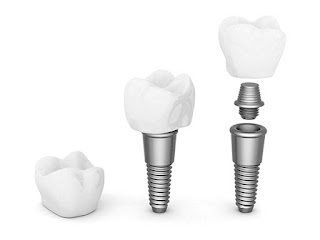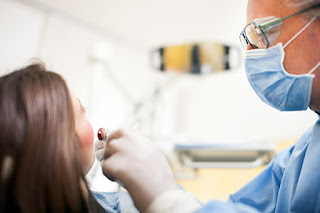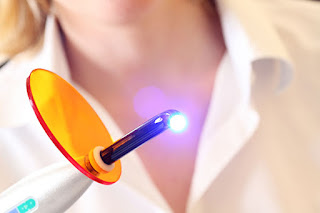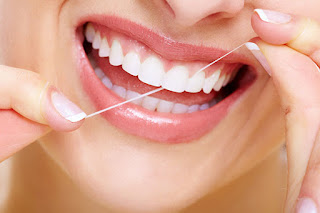Tuesday, December 15, 2015
Why You Should Consider Visiting an Oral Surgeon
Oral surgery is often a confusing term for patients, who look at everything in layman’s terms. For example, what is the difference between getting a root canal and having to remove your impacted wisdom teeth, other than the fact that one is done by your dentist and the other requires the services of an oral surgeon? This is exactly the same as in medicine when some simple procedures can be done by your general practice doctor, while other procedures need to be dealt with by a surgeon. The most common oral surgery procedures are removing impacted teeth and getting dental implants placed.
Impacted wisdom teeth are one of the most common problems that adults across the country have to deal with. Impacted wisdom teeth have to be removed using oral surgery. For most adults, their wisdom teeth appear much later than the other teeth. Since these are the third molars, there has to be enough room in the mouth and the jaw to allow the teeth to come in. Unfortunately, most times, the teeth do not have the room to come in straight or completely out of the gum. This is considered impacted and can have a significant and damaging effect on the teeth around the impacted wisdom tooth. Oral surgery can remove the teeth, preventing damage to the surrounding teeth and often relieving pain and swelling.
Another common reason for getting oral surgery is to replace lost or badly damaged teeth with dental implants. Dental implants are an excellent alternative to dentures or bridges for people who have lost their teeth. A tiny titanium screw is placed into the jawbone to act as the support for a fake tooth that is placed above the gum line. The new fake tooth is called a dental crown. Dental implants are extremely successful, very permanent, and last a very long time, but they do require oral surgery to place since they are surgically inserted into the jawbone. Often, people who have suffered bone loss in their jaw must have the bone replaced or augmented with oral surgery.
An oral surgeon is trained and skilled in the use of anesthesia to help make any procedure you get comfortable and as painless as possible.
Tuesday, December 1, 2015
Tips for Gum Recession Prevention
Gum Recession Definition and Causes
Gum recession typically occurs after a person has had gum disease, which is the infection and inflammation of the gum line. It is a side effect of the gums fighting off infection and growing weaker. Because of the stress, the tissues gradually break down. Gum recession can also occur simply due to congenital causes like thin, fragile gums, which is why so many people with healthy teeth and gums experience it. You also risk developing gum recession if you brush your teeth too vigorously daily. The persistent pressure on your gum line can cause it to recede. Crowded teeth and small jawbones are a few other causes of gum recession, in addition to many others. When gum recession occurs, the gingival margin (gum line) will gradually move away from the crown of the tooth, eventually exposing roots, causing discomfort, and leading to tooth loss.
Gum Recession Prevention
Brushing and Flossing
The best way to prevent gum recession is to keep up with proper oral hygiene practices. You should brush and floss daily. Brush your teeth at least twice every day, but more brushing, like after meals, is encouraged. You should floss once a day to keep food particles and bacteria from getting wedged into your gum line. Mouthwash can also be used daily after brushing and flossing to kill extra bacteria. These practices will help prevent gum disease that could lead to gum recession.
Regular Dentist Visits
Visiting the dentist regularly is also a great way to prevent gum recession. A dentist will be able to tell if you could be experiencing the early signs of gum disease or gum recession. They will be able to treat these conditions to prevent them from developing further. A dentist can also keep your teeth as clean as possible, so the likelihood of developing gum disease and recession is lessened.
Braces
Since crowded teeth can lead to gum recession, going through braces treatment could straighten your teeth and prevent recession from occurring. Braces can also make your teeth generally easier to clean, which leads to a healthier mouth overall.
Tips on Brushing
If you brush your teeth too aggressively, gum recession is inevitable. Try brushing your teeth with a firm but gentle circular motion to clean each tooth thoroughly and gently. If you need tips on getting the best clean without harming your gums, talk to a dentist. You should also ask your dentist what type of toothbrush is best for you.
These simple steps could help prevent gum recession. If receding gums are hereditary in your family, talk to your dentist about others ways you could keep your teeth and gums healthy and strong. We can fill you in on everything you should know about the causes and treatment of gum recession.
Monday, November 30, 2015
Oral Surgery: What You Should Know About Extractions
When you have impacted wisdom teeth, we need to perform an oral surgery to remove them. This process is typically done at the dentist office, so you are in a known and comfortable environment. Naturally, there is always the chance your dentist will decide that you need to be moved to a hospital for the oral surgery. Typically, this only happens when there is more than one tooth to be removed, the process could be longer and more complicated than a simple extraction, or if there is a concern about the patient's overall health. One thing to note: if your oral surgeon or dentist finds an active infection in your mouth, they will put off the oral surgery till a different day. This is because we never want to operate in the mouth when there is an active infection and so will prescribe a course of antibiotics to remove the infection before you go in for your oral surgery.
Most oral surgery, including wisdom tooth extractions, are performed under general anesthesia. Local anesthesia can also be used, which numbs the gums and tissue around the tooth. General anesthesia will put you to sleep, meaning you will be unaware of the process, feel absolutely no discomfort, and awake in a slightly groggy state. Because this procedure and any oral surgery done under general anesthesia requires the need to put you to sleep, we will require you to not eat anything for at least 12 hours before the procedure takes place.
For a wisdom tooth extraction, we start the oral surgery by cutting the gum open to reveal the tooth. If there is any connective tissue that is connecting the tooth to the bone, we will remove this first so the tooth is not holding the bone. If there is any bone covering the tooth, or teeth, we will remove that as well, so the extraction path is clear. Finally, we will remove the tooth, cutting it into smaller pieces if necessary for a smooth extraction. After the oral surgery is completed, we will close up the extraction site with self-dissolving stitches. These will eventually dissolve completely.
After any surgery, including oral surgery, you will need to take it easy for a few days. Pain medications can be used in the event you have any discomfort.
Tuesday, November 3, 2015
Your Gum Health Is Critically Important and a Periodontist Can Keep Gums Healthy
If you have not been to the dentist lately, there are several signs of gum disease you should watch for. Most of these you will notice when brushing your teeth. To start, look and see if your teeth appear longer than they used to. If so, this could be a sign of gum recession or your gums pulling away from your tooth structure. You should also look to see if your gums appear red, swollen, or are bleeding when you brush and floss your teeth. These can all be indicators of gum disease, and if you catch the condition early, you may not need a major treatment. However, the longer you let this condition fester, the more discomfort you will feel on a daily basis and the more intensive of a procedure will be necessary to correct the problem.
There are several ways a periodontist can restore your gums, including:
Deep cleaning. Very often, we can treat gum disease by performing a deep cleaning. Since gum disease is typically caused by plaque building up and becoming trapped under the gums, removing the plaque and tartar will remove the irritant and allow your gums to be restored to perfect health. This is the first step in any treatment plan because if the plaque remains, your gums will become unhealthy again.
Laser therapy. We use lasers to treat gum disease and to restore the health of the gums themselves. We can use them to break up the plaque under the gums and as a way to rejuvenate the gums and prompt growth due to gum recession.
Gum grafting. When the gums have receded to the point that your teeth are exposed and potentially becoming loose, major steps are required to correct it. We can do so using a gum graft. This is where tissue is taken from the roof of your mouth or from a donor and sutured to your gums before being pulled back around the teeth. Performing this procedure will help to keep your gums safe after they have receded. We also have a non-invasive method for doing this that does not require sutures or removing tissue from the roof of your mouth. To discuss our innovative solutions, call and schedule a consultation.
To schedule an appointment with a periodontist, call our office today. We are experts at what we do and will examine you before determining what type of procedure you need to ensure excellent gum health. Since we use a variety of treatment methods, you can count on us when you need treatment and want to recover quickly.
Friday, October 30, 2015
How Dental Implants Can Change Your Life
 If you have lost some of your teeth, you may not realize what a big difference dental implants can make. For many people, dental implants are life changing. This compilation of three ways dental implants can change your life is just the beginning of the many benefits they can provide.
If you have lost some of your teeth, you may not realize what a big difference dental implants can make. For many people, dental implants are life changing. This compilation of three ways dental implants can change your life is just the beginning of the many benefits they can provide.
Dental Implants Help You Stay Young Looking
Dental implants not only improve the necessary function of your teeth, but they can also drastically improve your appearance, making you look years younger. Implants make your smile fuller, filling in drooping areas of your cheeks, jawline, and lips. Once you receive dental implants, you will immediately notice that your facial skin is firmer, and your wrinkles are less noticeable. No matter what your age is, when you lose teeth it tends to make you look a decade older or more because you do not have a strong structure to keep your skin taut, and you develop a sunken appearance in your face. If you go without teeth too long, you may even lose bone structure since there are not teeth in place to keep your jawbone and other teeth from shifting.
Dental Implants Improve Your Chances of Succeeding in Your Career
Your smile is the first thing the majority of people will notice about you and one of the most vivid memories they will hold of your face. If you have less than impressive teeth, it may give off a false impression of your hygiene and happiness. Make a great first impression by receiving quality dental implants that look and feel real while also greatly improving your smile.
People who smile more often give off the impression of being more confident and content in life. When you are trying to succeed in life, it is important to look and feel confident so you can surpass your expectations and other's expectations of you. Allow us to give you more confidence and success by providing you with dental implants that perfectly fill in your already beautiful smile.
Dental Implants Make it Easier to Eat a Healthy Diet
When you are missing teeth, it is often easier to opt for foods that are not challenging to chew, but these foods also tend to have less nutritional value. Not getting proper nutrients can lead to the loss of more teeth, bone loss, weight loss, blood sugar problems, and long-term health risks. When you are ready to enjoy a proper meal again, complete with all the vitamins and minerals necessary to maintain a healthy lifestyle, dental implants can provide you with this power. Dental implants can also help you eat foods that you miss that you may not have been able to eat in years. Eating the foods you love makes life more enjoyable and provides you with a long life.
The procedure to receive dental implants typically only takes two to three visits, and within a few months, you will have strong, working teeth again. The artificial tooth roots that hold your replacement teeth in place are made of a titanium metal that fuses with your jawbone to create the strongest possible substitute for missing teeth. Dental implants can act on their own as replacement teeth, or they can be used to support dentures or dental bridges as needed. The options and benefits of dental implants are numerous and can change your life for the better in a few simple visits to our office.
Thursday, October 1, 2015
An Implant Dentist Explains How Dental Implants Work
 If you are interested in receiving dental implants to replace missing teeth, an implant dentist in our office can help you better understand the procedure that will take place to make this happen. Receiving dental implants is an exciting time and will provide you with attractive, hard-working teeth for years to come, but you should also be prepared to undergo the necessary procedure. We can help you learn what to expect during this process.
If you are interested in receiving dental implants to replace missing teeth, an implant dentist in our office can help you better understand the procedure that will take place to make this happen. Receiving dental implants is an exciting time and will provide you with attractive, hard-working teeth for years to come, but you should also be prepared to undergo the necessary procedure. We can help you learn what to expect during this process.
Consultation with an Implant Dentist
Before your procedure is solidified, you will need to meet with an implant dentist in our office so we can ensure dental implants are the right tooth replacement option for you. There are many factors we will consider such as general bone and soft tissue health, whether or not you have recently had periodontal disease (gum disease), and if your remaining jawbone is strong enough to support the implant. If you have a healthy mouth, you will most likely qualify for dental implants.
Dental implants are different from dentures and dental bridges, but they can be used as a base structure for dentures and bridges when necessary. Dental implants are typically stronger, longer-lasting, and more realistic in appearance than other tooth replacement choices. In some cases, they are also more costly, but the price is affordable when you consider an implant is as strong or stronger than your natural teeth, and the implant post itself should never need to be replaced.
How Dental Implants are Placed by an Implant Dentist
A dental implant is a post made up of titanium, a metal that is biocompatible and will eventually fuse with your jawbone. The post is basically a tooth root replacement, and it is surgically implanted into your jawbone. After implantation, it will take a few weeks to months for the implant post to osseointegrate with your bone. Once the fusion is complete, it will form the strongest replacement option for a missing tooth. Once the implant is stable, an abutment will be placed on the long-lasting implant. An artificial tooth will be screwed onto or bonded to this abutment. The artificial replacement tooth can be an individual prosthetic in the form of a custom-created crown top, a dental bridge, or even partial dentures. One implant can support a larger structure, making it an optimal option for one who is missing several teeth.
After Dental Implant Placement
Once an implant dentist finishes placing your dental implants, you will get to use your implants just like natural teeth. They should also be cared for like you would care for your real teeth. The stable implants allow you to chew the foods you couldn't while missing teeth, and they give you the ability to smile with confidence again. Dental implants will also prevent your face from looking sunken in and older because implants help maintain the natural, firm shape of your face.
To learn more about how dental implants are placed and how they can benefit your life, visit our office to speak with an implant dentist about receiving your very own dental implants.
Wednesday, September 30, 2015
FAQ's from a Cosmetic Dentist
In addition to being a cosmetic dentist, we are unique in that we focus on more complex procedures. With that in mind here are some facts that you should know –
Does a cosmetic dentist have a different way of replacing teeth?
Tooth loss is an incredibly common problem with most adults facing it at some point during their lifetime. Our goal is to replace your teeth in a way that feels, looks and behaves entirely natural. This is the best solution for your oral health and also for your appearance and well-being. This is why we offer dental implants. This is the only surgically placed solution to tooth loss. In this procedure, we implant a titanium post under the gums and secure it to the jawbone. Titanium is unique in that the body treats it like organic matter. As a result, the titanium post and jaw will fuse together. This process takes a few months, but it has amazing health benefits because the implant will begin to provide the jaw with the stimulation it needs to prevent resorption. Simultaneously, the implant will be as secure as a natural tooth. The end result is a tooth that looks and behaves so naturally that even you will have a difficult time telling it apart from your natural teeth. Since we specialize in oral surgery in our office, we are confident in our ability to provide you with superior results.
Is there a better way to treat gum disease?
Yes, as a cosmetic dentist, we focus on using the latest technology to treat gum disease. We believe that we can provide patients with the same high-quality care in a less invasive manner. This is better for your health and the appearance of your gums. As a result, we use laser treatments to both clean the gums and to restore them once they have started to recede. This means no sutures.
How can a damaged tooth be saved?
While we can certainly help with extractions, we believe in the importance of maintaining natural teeth whenever possible. As such, we recommend that damaged teeth be restored whenever possible. This can be done using dental bonding, dental veneers, or dental crowns – all of which can look entirely natural.
To learn more about cosmetic dentistry, call and schedule a consultation.
Wednesday, September 2, 2015
Dental Oral Surgery and Gum Recession
 If you need oral surgery for gum recession, we can help. It may sound scary, but our gum recession oral surgery will actually benefit your smile and oral health, rather than harm them. Oral surgery sounds more invasive than it is. We can provide you with a minimally invasive gum graft that will protect your teeth from the damage caused by gum recession.
If you need oral surgery for gum recession, we can help. It may sound scary, but our gum recession oral surgery will actually benefit your smile and oral health, rather than harm them. Oral surgery sounds more invasive than it is. We can provide you with a minimally invasive gum graft that will protect your teeth from the damage caused by gum recession.
Gum Recession
If you have questions about what gum recession is or what damage it can do, you can learn more by reading further or visiting our office. Gum recession affects up to 12 percent of adults, and it occurs when the margin of gum tissue surrounding the teeth begins to pull away or wear down. Gum recession is a gradual process that can occur over a several years. This process exposes teeth and vulnerable teeth roots. When the gums pull away from the teeth, pockets form, leaving an opening for bacteria to grow and harm the supporting dental structure of your teeth and gums. You could eventually experience persistent discomfort, tooth loss, and other structural damage. If you are unsure of whether or not you may have receding gums, visit our office for confirmation. It is vital to have gum recession treated as soon as possible in order for you to keep your smile natural-looking and healthy.
Gum Recession Causes
There are many causes of gum recession. Your genes are a major factor, with nearly 30 percent of patients having a predisposition for gum recession. Gum recession can be catalyzed by brushing and flossing too vigorously every day. Firm pressure is necessary to remove plaque, but a quality toothbrush should be doing most of the work, not intense pressure.
Periodontal disease, a severe gum infection, is another common cause of gum recession. Periodontal disease creates chronically inflamed gums that begin to deteriorate due to bacteria. If periodontal disease is not treated, it can easily get out of hand and cause accelerated gum recession and dental structure damage. Hormonal changes and poor oral hygiene are other reasons gum recession occurs. To learn more about how you can combat gum recession by caring for your teeth and gums properly, visit our office for instructions.
Oral Surgery for Gum Recession
Oral surgery also referred to as gum surgery, can be performed if you need to have your gums repaired before more damage occurs. The oral surgery we perform will provide more protection for your teeth and keep your dental structure from discomfort and infection. We can also provide you with oral surgery if you are interested in improving the appearance of your smile. Gum recession can cause your teeth to appear longer or protrude. A gum surgery can revert them back to their attractive, normal appearance. Before oral surgery, you will most likely receive a deep clean that could help your gums rebound on their own. Oral surgery options for gum recession include gum grafts, pocket reduction surgery, and tissue regeneration, among others.
When you visit our office for gum recession oral surgery, we will go into detail about the options you have for treatment. We will try to make the least invasive options work before we consider other surgical treatments. We will be able to improve your smile and your dental health in no time.
Monday, August 24, 2015
Our Pinhole Surgical Rejuvenation Procedure Is a Safe Way to Restore Your Gums While Pregnant
 Approximately half of the population of the United States suffers from gum recession; now, our minimally invasive pinhole surgical rejuvenation can restore gums, even if you are pregnant. Until now, there have been improvement options available, but they require long healing periods and invasive procedures. This unique procedure allows us to drastically improve the appearance of receding gums with little surgical intervention. The “surgery” that does occur is performed through a tiny, needle-point-size hole. This treatment is safe for pregnant women and encouraged if gum recession is a bothersome issue.
Approximately half of the population of the United States suffers from gum recession; now, our minimally invasive pinhole surgical rejuvenation can restore gums, even if you are pregnant. Until now, there have been improvement options available, but they require long healing periods and invasive procedures. This unique procedure allows us to drastically improve the appearance of receding gums with little surgical intervention. The “surgery” that does occur is performed through a tiny, needle-point-size hole. This treatment is safe for pregnant women and encouraged if gum recession is a bothersome issue.
Pinhole Surgical Rejuvenation
No one likes the appearance of receding gums. Not only is it unsightly, but it can also put your teeth and dental health at risk for infection and damage. Potential problems include teeth that look grossly elongated, discoloration of teeth, quicker and more extensive tooth decay, root damage, and even tooth loss. With pinhole surgical rejuvenation, you can have gum recession corrected before it causes these problems, in an incision-free, suture-free procedure. A needle makes a tiny hole, through which specially designed surgical instruments loosen areas of gum tissue and place it back over the exposed area of the tooth. The gum tissues can also be rejuvenated with a unique collagen material. No cutting is necessary for the procedure, so the healing time is minimal and symptoms following the procedure are minimal or nonexistent. You will also be able to see an immediate improvement in your gum recession.
Why Pinhole Surgical Rejuvenation Is Safe During Pregnancy
More bacteria naturally occur in the mouths of pregnant women. If receding gums exist, you are already at risk for an infection. Any dental treatment or procedure that requires incisions or invasive work can leave healing wounds that may easily develop into an infection due to the overproduction of bacteria. Since no incisions will be made with pinhole surgical rejuvenation, side effects like bleeding, swelling, and discomfort are kept at a minimum, and infection never occurs.
With traditional procedures used to improve gum recession, like gum grafting, the use of donor tissue or tissue from another area in the mouth is used to rebuild the gum line. This process takes several incision sites and sutures, as well as a long recovery time. The longer it takes for a wound or incision to heal, the longer it is exposed to bacteria that already exists in the mouth. Antibiotics can be taken during this time, but any unnecessary medication use is advised against during pregnancy. Instead of risking the complications of other gum recession improvement techniques, visit us for a safe and effective pinhole surgical rejuvenation.
Following pinhole surgical rejuvenation, you will notice an immediate improvement in the appearance of your smile and gums. The results speak for themselves: according to the International Journal of Periodontics and Restorative Dentistry, 95 percent of patients who have undergone this procedure are happy with their results. Please call or visit our office if you would like more information about pinhole surgical rejuvenation and how it can improve your smile, even during pregnancy.
Tuesday, August 4, 2015
Who Is at Risk for Gum Recession?
 Gum recession is a common problem that affects the dental structure of many people. Most patients do not even know they have receding gums because it occurs over an extended period of time. Gum recession is a long process in which the edge of the gum tissue that attaches to the tooth's surface begins to wear and pull back, revealing more of your tooth and the structures that support it. As gum recession occurs, pockets in the gums can form, leaving them more vulnerable to bacteria buildup and severe gum disease. The first signs you may have gum recession are tooth sensitivity, gum redness, gum irritation, or teeth that appear long. If not treated, gum recession can lead to tooth root exposure, tooth loss, and the damage of the supporting bone structure.
Gum recession is a common problem that affects the dental structure of many people. Most patients do not even know they have receding gums because it occurs over an extended period of time. Gum recession is a long process in which the edge of the gum tissue that attaches to the tooth's surface begins to wear and pull back, revealing more of your tooth and the structures that support it. As gum recession occurs, pockets in the gums can form, leaving them more vulnerable to bacteria buildup and severe gum disease. The first signs you may have gum recession are tooth sensitivity, gum redness, gum irritation, or teeth that appear long. If not treated, gum recession can lead to tooth root exposure, tooth loss, and the damage of the supporting bone structure.
Signs of High-Risk Gum Recession Candidates
Gum recession can occur for many reasons. Commonly, gum recession is a genetic problem. Other contributors to gum recession are gum disease, poor oral hygiene, tobacco use, pregnancy, menopause, teeth grinding, aggressive teeth brushing, and crooked teeth.
Gum Disease: Gum disease as a result of poor oral hygiene is the main cause of receding gums. Gum disease, or the more severe version, periodontal disease, is a bacterial gum infection that causes chronic inflammation, tissue deterioration, gum bleeding, discomfort, and potentially tooth loss. Since gum disease causes so much inflammation and tissue deterioration in the gums, gum recession is one of the most prevalent symptoms. Gum disease can be prevented by visiting the dentist regularly and employing proper at-home oral hygiene care.
Poor Oral Hygiene: Poor oral hygiene quickly leads to an overproduction of bacteria and plaque in the mouth. When plaque is not removed by regular brushing and dentist visits, it develops into a harder form called tartar that can only be removed professionally. Tartar and bacteria growth lead to inflamed gums and gum disease, which have the symptom of gum recession.
Tobacco Use: The toxins in tobacco irritate the soft gum tissues, leading to inflammation. Chronic inflammation can cause tissue depletion and recession.
Pregnancy and Menopause: Pregnancy, menopause, and other hormonal changes contribute to gum recession. The hormone fluctuation makes gums more sensitive to everyday use, leading to gum recession.
Teeth Grinding: Vast amounts of unnecessary pressure caused by teeth grinding and other bad habits, like nail biting, lead to gum recession.
Aggressive Teeth Brushing: If you are brushing your teeth too hard, your gums will gradually get pushed further back, resulting in gum recession and exposed tooth roots. When brushing, use a firm, but gentle circular motion to thoroughly cleanse each tooth and the gums. No excessive pressure is needed.
Crooked Teeth: When your teeth are crooked, different areas receive more pressure during chewing and speaking. This can lead to heavy use and pressure on certain areas of your gums, which will then cause gum recession. If you have one or two teeth that continually irritate an area of your gums, you may notice gum recession in this localized area. Crooked teeth also make it harder to reach every inch of your gums during flossing, which can lead to bacteria buildup and gum recession.
These are just a few reasons why some patients are at more of a risk of developing gum recession. We can help stop your gum recession, remove damaged tissue and bacteria, and improve the structure of your gums when you visit our office. If you have questions about how you can prevent gum recession, we can also answer those inquiries.
Friday, July 31, 2015
Change Your Smile With Help From a Cosmetic Dentist
Friday, July 3, 2015
Dental Implants Have Revolutionized The Process of Replacing Teeth
Tuesday, June 23, 2015
How Laser Dentistry is Used During Oral Surgery
Benefits of Laser Therapy, aka Laser Dentistry
Like mentioned above, laser dentistry allows for a fast recovery time and a less invasive surgery for patients. This provides convenience and less chair time for each patient. Many of our laser treatments do not require anesthesia which allows patients to leave our office directly following surgery without feeling hesitant or nervous about driving with an anesthetic in their system. Even though they leave your system quickly following a procedure and are completely safe, many people are still wary of the option. Also, because our laser treatments are so precise, there is a lower chance of bacterial infection developing. There is also less possibility of scar tissue developing or bleeding and swelling following surgery. With all of these benefits, our patients go into their oral surgery comfortably with their minds at complete ease.
Types of Laser Dentistry
There are two main types of laser dentistry that branch out into multiple types of procedures. There is hard tissue laser dentistry and soft tissue laser dentistry. Hard tissue laser therapy includes treatment of cavity detection and removal, as well as the application of dental fillings. This type of laser dentistry is used to improve sensitivities in teeth and to perform an alternative root canal therapy to the classic methods.
The second type of laser dentistry is soft tissue laser therapy. When your gums need reshaping, redirecting, or general gum surgery, we can use soft tissue laser dentistry as a less invasive option to those performed using traditional dental tools. We can also provide you with a muscle attachment improvement, oral lesion or tumor removal, biopsies, periodontal disease treatment, removal of bacteria from below your gum line, and sleep apnea treatment with the use of laser dentistry. These are all considered soft tissue laser dentistry.
Where Laser Dentistry Cannot Be Used
Although there are many areas of oral surgery and general non-invasive procedures in which laser dentistry can be used, there are a few areas in which it cannot. The additional use of polishing tools may be needed to finish off fillings in order to create a smooth surface. Shaping tools may also be employed. Laser dentistry may not be used around some already placed fillings and crowns.
Our office has found that laser dentistry is more useful and versatile than many realize. For those suffering from anxiety when faced with traditional tools, laser dentistry is a safe and viable option that may produce less fear in patients. Our laser dentistry technology is advanced and can perform smooth and successful oral surgery. Contact our office to learn more about this state-of-the-art technology.
Wednesday, June 3, 2015
Learn How to Prevent Gum Recession
• Visit the dentist.
It may sound like an obvious solution, but many people avoid visiting the dentist on a regular basis. This prevents them from realizing when they may be at risk for gum recession. When you visit a dentist for an appointment, we can notify you if we notice any signs of recession or gum disease. We can also direct you to changes that need to be made to your oral hygiene regimen. This can be invaluable information when you are trying to prevent detrimental and unsightly gum recession.
• Adjust your brushing habits.
When you use a toothbrush that is too hard or puts too much pressure on your teeth and gums when you brush, you are weakening your oral tissues. Aggressive brushing habits may seem like a good idea to deter plaque from developing, but they are actually making your teeth and gums more vulnerable to other problems like gum recession and tooth loss. Brush your teeth with a firm, but gentle pressure and circular motion. If you have been using a toothbrush with hard bristles, you may also consider getting medium or soft grade bristles.
• Over flossing may be the culprit.
Flossing is a wonderful habit to have, but when you over floss, you could be weakening your gums. Flossing removes plaque, but once you have flossed once or twice a day, you should avoid doing so anymore unless you have something stuck in your teeth. Flossing too much puts unnecessary pressure on your gums and may encourage them to recede.
• It may be in your genes.
Unfortunately, you may just have an inherited predisposition for thin gums and gum recession. If this is the case, you should definitely be brushing more gently, and you should consider having a gum graft before your gum recession becomes severe.
• Biting your nails, pencils, or any other foreign objects.
If you have the habit of putting objects into your mouth to chew on, you may also be scratching your gums without noticing. You should already be trying to stop these biting habits as they are bad for your dental enamel, but they can also lead to gum recession.
• Periodontal disease could be to blame.
Periodontal disease, a severe form of gum disease, is the main culprit of gum recession. To avoid developing periodontal disease, practice proper oral hygiene and visit a dentist at least twice a year for check-ups and cleanings.
Once you form these habits, you should be on the road to better oral health and less likelihood of developing gum recession. Also, keep in mind that you should visit your dentist every 3-6 months if you think your gums may already be receding. A dentist will be able to keep an eye on the amount of gum tissue you are losing. We can also perform a gum graft as needed and help with extreme cases of gum recession.
Tuesday, May 26, 2015
Pinhole Surgical Rejuvenation vs. Tissue Grafting
What Causes a Receding Gum Line?
Receding gums, a fairly common dental problem, expose the lower part of the tooth. Unfortunately, gums recede so gradually that most people do not notice it in the early stages. Usually, the first signs are a sensitive tooth or, a tooth that looks longer than it once did. While genes do sometimes play a part, the most common cause of gum recession is periodontal disease, a bacterial gum infection that infects and destroys gum tissue along with the supporting bone structure. Inadequate oral hygiene causes plaque to build up on and in between your teeth. This sticky substance eventually turns to a much harder substance called tartar that causes gum recession. Once formed, tartar can only be removed professionally. Too aggressive tooth brushing can also wear away tooth enamel that causes the gums to recede, as does clenching or grinding your teeth. Fluctuating hormone levels such as occur during pregnancy, puberty or menopause, also causes gums to become more sensitive to disease. Poor blood sugar control in diabetics render them more susceptible to gum disease.
Because gum tissue is the only barrier between bacteria and the bones and tissue that support your teeth, if the recession is left untreated, these bones are likely to be damaged which will ultimately lead to tooth loss. The right amount of protection and treatment is, therefore, essential.
Pinhole Surgical Rejuvenation Vs. Tissue Grafting
Tissue Grafting
If the pockets in your gums are too deep to be restored by a cleaning, then the traditional treatment is a soft tissue graft taken from the patient's palate, or from a donor. This tissue is then sutured on the receding gum covering the previously exposed root. However, as you can imagine, cutting tissue from the roof of the mouth and stitching it onto the gum line is not only uncomfortable, but takes several days to heal. Besides which, the sutures have to be so small that they usually take a long time to do, which means only a couple or so teeth can be treated at one time.
Pinhole Surgical Rejuvenation
PSL requires no incisions and, therefore, no sutures. After giving you a local anesthetic, we will use a needle to make a small entry point in the gum. A specially designed instrument, inserted through this hole, gently loosens the gum tissue and slides it over the receded part of the gum. This new position is held by several strips of collagen that are inserted through the original pinhole, with the help of a small angled instrument.
And that, quite literally, is all there is to it.
The entire procedure is done in far less time than traditional grafting, which means that several teeth can be treated in one sitting, and the downtime is virtually non-existent. Although we cut no flaps in your mouth, remove no tissue, make no incisions, and use no sutures, you have a new re-built gum line that is not only much healthier and protects your teeth far more adequately, but also vastly improves your smile. To learn more about Pinhole Surgical Rejuvenation, call and schedule a consultation.
Tuesday, May 5, 2015
Laser Dentistry is the Way of the Future
Traditionally lasers were only used for oral surgery, something we continue to use them for in our office. Additionally, treatment of the gums and teeth is now a reality, and it is successful upward of 95% of the time. Laser dentistry, for use on oral health challenges like cavities or to remove decay, may sound very futuristic. In reality, we are doing it now, using a technology that is head and shoulders above the competition.
As a laser dentistry practitioner, one of the most frequent questions we are asked is why lasers are considered to be superior to some of the traditional tools used by dentists. We believe in evolution, and dentistry is an evolving practice, with lasers being the up and coming technology. This alone makes them better, but there is much more. For starters, lasers help people who have a profound fear of the dentist chair. We have found that statistically over 20% of all patients, in keeping with the national average, experience a great deal of anxiety when visiting the dentist. An additional 5% to 8% will not even visit the dentist because their fear is so great. A lot of this fear comes from the use of tools like an electric drill inside of the mouth. The drill and other metal dental tools were used on a frequent basis until the advent of laser dentistry. Using a completely soundless laser, we can perform the same procedures in a fraction of the time. For people with fears this means we are not only lessening the time you need to spend in the chair but are also removing the most traumatic part of dentistry, the drill.
Laser dentistry even takes things to the next level in pain management. For procedures like treating gum disease, traditional dentists would need to use anesthesia, either local or general. However, a 2002 Japanese study found that laser dentistry could complete the same procedure without needing any anesthesia at all. In the patients who were treated, 65% experienced no discomfort at all, despite the lack of anesthesia. An additional 22% experienced very mild discomfort while a further 4% experienced tolerable discomfort. In total, 91% of the patients were treated without anesthesia for a very common dental ailment. We have also found that the use of lasers allows our patients to remain more comfortable during their treatment while also decreasing the overall recovery time. To learn more, we invite you to call and schedule a consultation.












